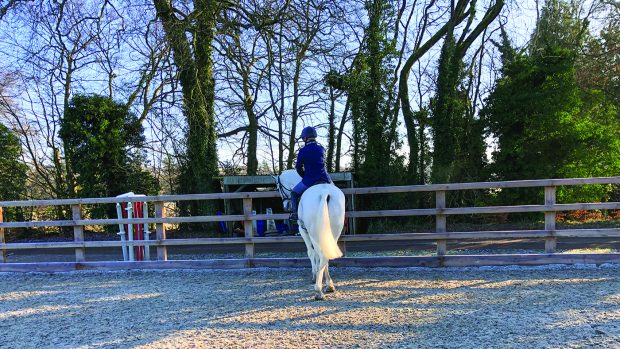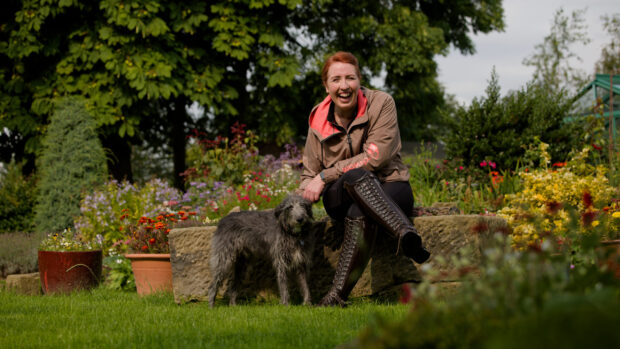Ever since the well-documented day when Salinero bolted in the prize-giving at Aachen with Anky van Grunsven in 2006, there has been debate over prize-givings.
Do horses enjoy them, or are they a source of fear, with one scary experience scarring them long-term and making them dangerous to ride in a charged atmosphere?
Many riders want their picture taken on a lap of honour with rosette fluttering, but others feel that standing in line quietly while an audience claps followed by a (hopefully sedate) lap of the arena is simply too much to ask of some sensitive horses.
It is somewhat ironic that in dressage, the equestrian discipline which arguably requires the most fine control, that the prize-giving issue remains such a hot potato. Showjumpers and eventers don’t seem worried by them.
So what can you do to ensure both your own and your horse’s safety, while still having the opportunity to get that lap of honour picture snapped if you want it?
Australian “dressage cowboy” Tristan Tucker asserts that many riders only ever train for 50% of a show, pointing out that “the other 50%” is all the scary objects, flowers, banners and noise that a horse has to deal with. So, he reasons, why not train them specifically to perform with all these distractions?
Tristan re-trains horses’ reactions to spooky objects (banners, judges’ boxes) using pressure and release techniques.
“I teach horses to take ownership — when I ask something of them, it then becomes their responsibility to do it and be proud of it and offer it,” he explains.
“It’s not ‘desensitising’ as they are learning a new response, not no response.”
His techniques involve empowering horses to go towards scary objects.
Continued below…

Prize-giving etiquette: dos and don’ts
From rearing up to falling down, or exiting the arena at high speed, the resulting behaviour can cause carnage in
Start at home
Begin with a small flag or similar and encourage the horse to touch it with his nose. When he does so — however long it takes — take it away. The horse begins to learn that by having the courage to approach and touch an object, the threat of it is removed.
This can then be done with larger objects until the horse is completely comfortable.
Start with ground work, progress to ridden work with a helper on the ground who can quickly remove any “threats” (objects) and, once the horse is confident, to riding alone.
Other methods to accustom horses to the sensations they might experience in a prize-giving include playing a recording of clapping in their stable. Start with the volume low and build it up; playing music — sometimes loudly — can also prepare them for the onslaught of a big occasion or the rigors of freestyle to music classes.
Step-by-step top tips from behaviorist Michael Peace:
- Firstly, make sure you’ve engaged the part of the horse’s brain that deals with the flight response and reaction to danger. You need to help your horse to become (or remain) rational, so stop them planting or running away from things they don’t understand. You need to work to change the horse’s default response.
- So, to start with, give the horse time to think things through. This may simply be a puddle he refuses to go through; allow him time to think and don’t ‘haze’ him through it by kicking, flapping or growling. That might solve the problem for the time being, but you’re not addressing the real issue.
- Make the horse pause and consider where his body is approaching whatever scares him, going past it, and away from it. This works equally well with a stream or fallen log out hacking — or something scary in the arena.
- Always give the horse time and the opportunity for them to understand. Anything he is worried about it’s essential that you teach him the right reaction which will become the default in the future — rather than running away at 100 miles an hour. This applies to bitting and putting a saddle on a young horse, too.
- To help a horse frightened of clapping, find a school with a gallery, preferably a tiered one and fill it with friends. This environment is up a level from the puddle or log exercise, but is specific to training for a prize-giving and uses the same methods of systematic desensitization.
- Like with people, phobias usually seem a bit ridiculous once you’ve got over them; teach the horse that the thing he was scared of really isn’t that bad.
- Start far away from your ‘audience’ and ask them to begin by clapping quietly. Give the horse encouragement and allow him to go right up to the point where he says ‘I can’t do this’. At that moment, back off by asking the audience to be quiet, then repeat the exercise, slowly minimizing the horse’s distance from the crowd and increasing the crowd’s volume.
- Building a horse’s confidence is like building a pyramid of cards; if you overstep the mark you have to come right back down and start building again. Each stage is fragile.
- Remember, if a horse becomes scared, he’ll hold you responsible for that, so your part in the process is critical.
- If you yourself have baggage about attending a prize-giving, it might be advisable to ‘jock yourself off’ and ask someone more confident to help your horse become more so, as you don’t want to feed the horse’s anxiety. This is the sports phychology element.
- To put the training into practise, choose environments where if it does go wrong then it’ll be ok, so maybe start with smaller events so if it all goes a bit pear shaped, it’s not the end of the world. It’s awful to have bad experiences at big events. Riders can be frowned upon and then get self-conscious and the whole thing can spiral out of control.
Watch Michael working with a police horse frightened of clapping





